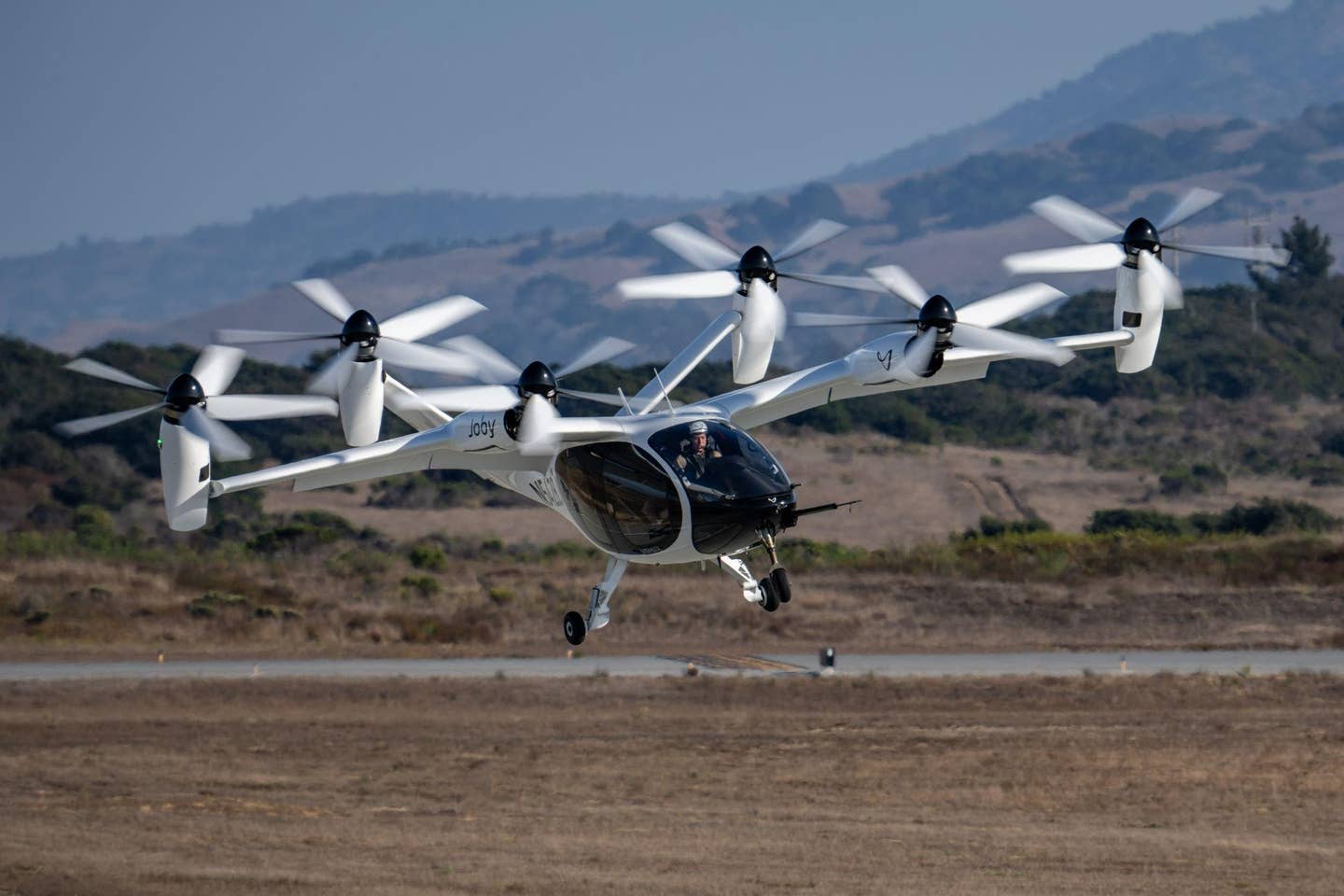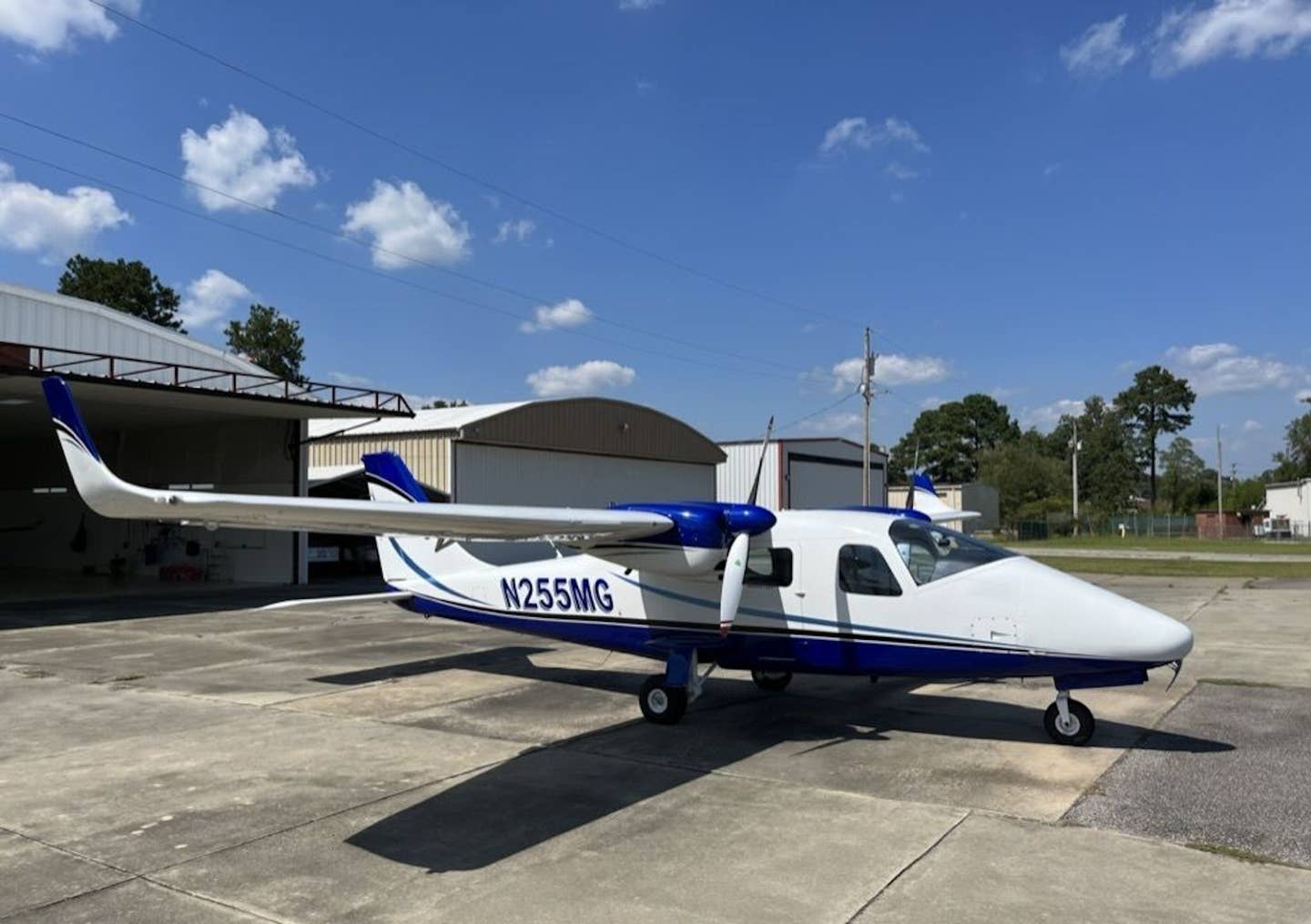Joby’s Electric Air Taxi Is Now Flying with Pilots on Board
The eVTOL manufacturer Joby Aviation hit another key milestone on its path to type certification with the introduction of crewed test flights.

Joby experimental test pilot Zach Reeder conducts flight tests onboard the Joby air taxi in Marina, California. [Courtesy: Joby Aviation]
Joby Aviation’s preproduction prototype electric vertical takeoff and landing (eVTOL) air taxi has been flying for months since the manufacturer began flight testing in June. Now, the company’s test pilots have joined it in the skies.
On Wednesday, Joby revealed that four test pilots have now completed flights aboard its air taxi, marking the firm’s transition to crewed flight testing. The addition of onboard pilots is a major boon to Joby’s efforts to type certify the aircraft with the FAA. The initial crewed tests, which took place at the company’s pilot production facility in Marina, California, covered free thrustborne hovers and forward transitions to semi-thrustborne flight.
Joby’s tiltrotor eVTOL is designed to carry a pilot and four passengers over a distance up to 100 sm (87 nm), cruising at 200 mph (174 knots). The company says the aircraft’s quiet noise profile will make it barely audible within a city’s soundscape.
The recent flights build on the surprise delivery of the first Joby eVTOL to Edwards Air Force Base in California, originally scheduled for early 2024. There, Joby and Air Force pilots will evaluate the aircraft’s capabilities in settings similar to those it will face when it begins flying air taxi routes with Delta Air Lines. That service is expected to launch in 2025, beginning in New York and Los Angeles.
James “Buddy” Denham, Joby’s chief test pilot, led the pilot-on-board campaign, which was designed to gather data on the air taxi’s handling abilities and pilot control interface. Denham left the Naval Air Systems Command—where he pioneered a concept for aircraft carrier precision landings and led research and development of the Unified Control Concept, which was integrated into F-35B STOVL aircraft—to join Joby in 2019.
Joby credited Denham as a major influence in the development of its own flight controls. The chief test pilot had some nice things to say about the company as well.
“Having helped design and test flight controls for a wide variety of aircraft, including all three variants of the F-35 Joint Strike Fighter, nothing compares to the simplicity and grace of the Joby aircraft,” said Denham. “After completing more than 400 vertical takeoffs and landings from the ground, it is a privilege to sit in the cockpit of our aircraft and experience firsthand the ease and intuitive nature of the design that the Joby team has developed.”
During testing, pilots assessed the ease of conducting maneuvers that will become routine when commercial operations begin. These included vertical takeoffs, acceleration and transition to forward flight, runway centerline tracking, and deceleration into vertical landings.
Joby said appraisals of the flights will aid its progress toward type certification, as well as its activities with the Air Force’s Agility Prime program. Agility Prime is the vertical lift division of AFWERX, the Air Force’s innovation arm. Earlier this year, Joby and Agility Prime extended their research and development contract, bringing its total value to $131 million.
Type Certification: On the Horizon?
Previously, Joby tested its eVTOL with pilots on the ground, using a ground control station equipped with state-of-the-art communications systems to guide it remotely. Those flights gave the company data on the aircraft’s performance in a wide array of operational conditions. But the beginning of crewed testing figures to be more consequential.
After pilot-on-board testing of the preproduction prototype is complete, the stage will be set for Joby to begin “for credit” flight testing with the FAA, using a full-scale production prototype. That model may be built at the company’s scaled manufacturing plant in Dayton, Ohio, which was first announced last month.
Dayton’s claim to fame is that the Wright brothers lived, worked, and opened the nation’s first airplane factory there (hence the Flyers mascot). It’s also home to Dayton International Airport (KDAY), where Joby will build its manufacturing plant on a 140-acre-site. The space is large enough for the company to one day install up to 2 million square feet of facilities. It is expected to produce 500 aircraft per year and create as many as 2,000 jobs.
Construction will begin next year, with full-scale operations scheduled for 2025. In the meantime, Joby will use nearby existing buildings to begin initial manufacturing activities. The goal will be to wheel the first service-ready aircraft off the production line within two years, in time for the company’s commercial launch with Delta.
In addition, Joby has commercial operational deals in place with Japan’s ANA Holdings and South Korea’s TMAP and SK Telecom to launch services in those countries. It also has an agreement with Uber—part of the 2020 acquisition of Uber Elevate—to integrate its ridesharing service into the company’s app.
However, all of this hinges on Joby’s ability to prove to the FAA that its air taxi is airworthy. Luckily, rivals such as Archer Aviation and Lilium are going through the same (lengthy) process. Archer, for its part, also received the FAA greenlight to begin flight testing its preproduction prototype in August. Lilium, meanwhile, is the only eVTOL manufacturer to obtain certification bases from both the FAA and the European Union Aviation Safety Agency (EASA).
The three firms—plus Boeing-owned Wisk Aero and Germany’s Volocopter—are all competing to be top dog in the advanced air mobility (AAM) industry, which is expected to take off soon with the FAA’s announcement of the Innovate28 plan for early eVTOL operations. Whichever firm achieves type certification first will realize a lot of lift.
Like this story? We think you'll also like the Future of FLYING newsletter sent every Thursday afternoon. Sign up now.

Subscribe to Our Newsletter
Get the latest FLYING stories delivered directly to your inbox






